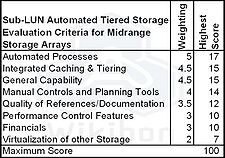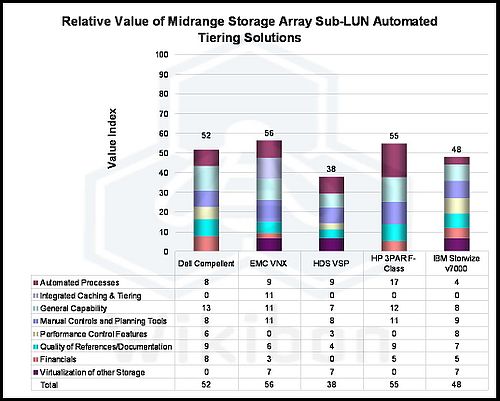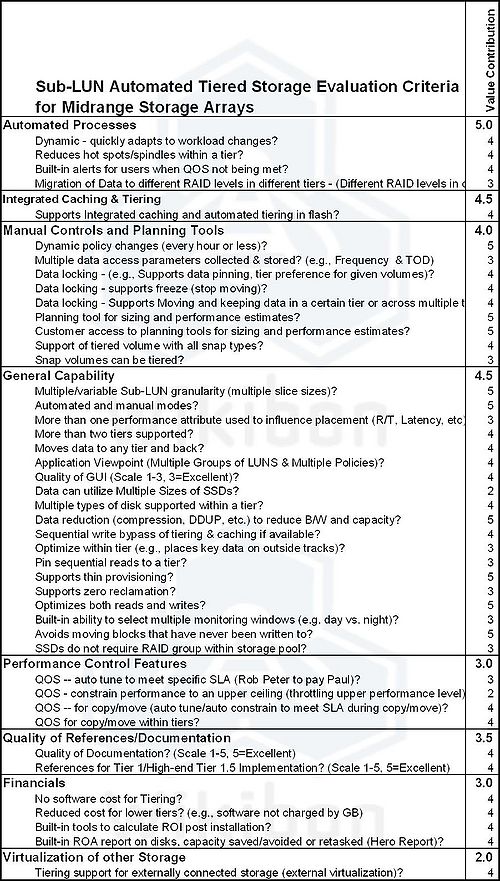Assessment of Automated Tiered Storage for Midrange Arrays
From Wikibon
Originating Authors: David Floyer and Nick Allen
In December 2011, Wikibon published research on Automated Tiered Storage (ATS) for higher-end storage arrays, and concluded that ATS was cost-justified (reduced storage costs by about 20%) and ready for "prime time". Wikibon found that a key element in the higher-end arrays was control over the environment. Most users, supported by early user experience, were not ready to allow the mission-critical applications to be managed by a “black box”.
This follow-on research extends the original research to the midrange marketplace. Wikibon found that automation and integration are most important for this market segment. Wikibon found that the users of ATS on midrange storage arrays to be very happy that it provided lower cost storage. Figure 1 provides the findings of our comparative research, and found a statistical dead-heat between the EMC VNX (which provided the best (and only) integration between cache, flash-cache, and ATS) and the HP 3PAR F-class, (which provided better automation).
Wikibon strongly recommends the adoption of ATS on existing arrays where possible, and the inclusion of ATS functionality on RFPs for midrange storage arrays.
Contents |
The Business Case for Automated Tiered Storage
The initial implementations of automated tiered storage (ATS) were volume based – whole volumes were moved to a different tier of storage according to the usage characteristics of the volume. This had some take-up in enterprise data centers, but because of the impact of moving a whole volume on performance, this transfer was almost always performed as a background task during periods of low storage activity. The introduction of sub-volume-based (often called Sub-LUN) ATS has significantly increased the interest in ATS, as now only small blocks of data need to be moved. This allows dynamic movement of data at any time and has enabled much better business cases to be made, resulting in many more ATS deployments.
The current business case for tiered storage is simple – reduced cost of storage and reduced cost of managing storage. The expectation is that long-term, risk can also be reduced as the products improve and users become comfortable with the new business processes required to manage tiered storage. The estimates of savings are:
- Cost of Storage (CAPEX): By allowing data to be migrated down according to actual usage, data can be optimally placed in the storage hierarchy, and less SSD and high-performance disk (SAS or FC) is required. Wikibon has found a range of savings from 15% to 30%, depending on how aggressive the implementation. Wikibon believes that for early adopters, an expectation of a 20% reduction in acquisition cost over the life of an array is reasonable. (Note: there is significant benefit that can be derived from virtualized storage pools and thin provisioning, in the range of 15-30%. ATS and virtualized storage pools/thin provisioning may be implemented together, but the benefits of storage pools and thin provisioning can be obtained independently from ATS and should not be included in the ATS business case. Virtualized storage pools are a pre-requisite for sub-LUN ATS).
- Cost of Storage Management (OPEX): Fewer storage and database administrators are required. Wikibon has found a range of savings from 10% to 20%, depending on how aggressive the ATS implementation is. As there is a requirement for a different kind of storage management to monitor risk, Wikibon believes that for early midrange adopters, an expectation of 10% is reasonable. As ATS matures, this should rise to 20% and higher.
- Risk Reduction: Automation of the complex task of storage placement should in theory help reduce the risk of not meeting service level agreements with end-users and improving availability. However, in the early stages of development of ATS and early adoption experience, Wikibon does not believe that it is reasonable to include risk reduction in a business case. Risks could actually be increased if implementation safeguards are inadequate and if the correct monitoring capabilities are not implemented.
The bottom line is that the potential savings are meaningful. Specifically, our research with early practitioners suggests that ATS is an evolutionary technology that will be widely adopted and shave storage TCO by 20-25% over a four-year period. Wikibon believes that ATS will become widely adopted over the next five years for all classes of workload. As the ATS products and data center processes mature, Wikibon believes that risk reduction will become the most significant driver as automation will lead to higher availability and a better user experience. Wikibon cautions users to gain experience with ATS prior to arguing for reduced risk as a near term business benefit, especially for mission-critical data.
Midrange Storage Arrays Analysed
Wikibon picked the single most popular platform from each of the major vendors to analyze. The initial list was:
- Dell Compellent using Data Progression,
- EMC VNX using FAST VP ATS together with FastCache software
- Hitachi AMS,
- Hitachi VSP using Dynamic Tiering ATS software,
- HP 3PAR F-Class using Adaptive Optimization ATS software,
- IBM Storwize 7000 using Easy Tier ATS software,
- IBM XIV,
- NetApp FAS Series.
Three arrays were not analyzed because they did not offer an ATS solution. They were:
- Hitachi AMS.
- Hitachi HUS system – this array family is new into the marketplace. Tiered storage is offered for file-based storage, but not initially for block-based storage. Wikibon expects ATS block-based storage solutions to be available in the future and hopes to analyze them once they enter the marketplace.
- IBM XIV (Flash can act as a read-only cache. The fundamental architecture of the XIV, which spreads two copies of data across all drives, only allows a single tier of storage.)
- NetApp FAS Series (Flash acts as a read-only cache. NetApp offer manual movement of data between tiers but has been resistant to providing an automated tiered storage solution.)
The Hitachi VSP and IBM Storwize 7000 were analyzed in the previous research. The weightings, comparison categories, and questions were all slightly altered for the midrange comparison.
ATS Evaluation Criteria & Methodology
Wikibon looked at the ATS functionality for midrange arrays required for typical midrange workloads. Wikibon interviewed Wikibon members that had implemented or were implementing ATS for mission-critical and other workloads. As was the case with the Tier 1 customer that Wikibon interviewed for the prior study, Wikibon found high activity and the expectation that midrange customers would also deploy ATS. Wikibon discussed the importance of the functionality requirements for the midrange with members.
Table 1 provides the evaluation criteria functionality groups that Wikibon developed and used in this analysis, and their relative weightings. Because midrange ATS is often implemented in data centers with limited technical resources, high weightings were given to automation, integration, and planning capabilities. Less weighting was given to general capabilities and financials. Table 1 also shows the maximum score that is available within each criteria, with the overall maximum score being set at 100.
Wikibon expects that as products mature and understanding increases with adoption, the evaluation criteria and weightings will change. The requirements and criteria for ATS on other storage array tiers will be different, and it would be misleading to apply the findings of this study to other workloads/storage tiers.
Within each of the evaluation criteria are specific functionalities, as shown in Table 2, together with the relative importance within the criterion on a 5 point scale. All of these functionalities are assessed for each of the storage arrays as available/not available (Y/N), except for questions on Quality of GUI and data locking, which are assessed on a three point scale and two questions on quality of documentation and references, which are assessed on a five point scale.
Key Findings
The results for the adoption stage of midrange ATS implementation are shown in Figure 1.
Wikibon performed a detailed analysis of vendor specification sheets and requested and conducted interviews with all the vendors included in this study. Wikibon received good support from all the vendors.
The key findings of this study include:
- The range of quality of implementation in the marketplace varies widely. The EMC and HP 3PAR F-class were in a statistical dead heat for the top spot, with the Dell Compellent very close behind.
- There is a difference of integration philosophy for the EMC VNX, which integrated the array controller cache, the flash-cache and the ATS functionality. Wikibon believes that this integration is an excellent approach for the midmarket, giving greater overall automation and ease of use.
- The HP 3PAR system had the best automation features of the arrays examined in detail.
- The references that Wikibon interviewed were universal in their satisfaction with ATS, and supported the overall findings in terms of savings. The Compellent references were sold on the benefit that, after the initial deployment, all additional storage requirements could be met with only high capacity disk (space required on the high performance disk or flash tiers was freed up automatically by migration of older data to the lower tiers). These references confirmed that this benefit was achieved in practice, and senior management could easily be shown the benefits of ATS with the “hero reports”.
- Wikibon believes that the major benefit of ATS for the midrange is cost savings, as fewer high-performance disks are required to deliver the same performance. This saving is in the order of 25%. All the ATS implementations could achieve near this level of saving, with the exception of the IBM Storwize 7000, which is hampered by its support of only two tiers.
- Tools to map today's environment to the future state are lacking and often highly reliant on vendor services to specify the system (pre-installation). Also, post-installation performance monitoring tools are rudimentary. This should be a focus for vendors to improve adoption and reduce the sales cycle work for the channel.
- Midrange arrays that do not offer ATS are at a distinct disadvantage in the marketplace. Wikibon expects that the new HUS midrange arrays from Hitachi (replacing the AMS Series) will include ATS functionality in the future. The IBM XIV fundamental architecture precludes the use of flash, which will limit the scope of XIV adoption to situations were only "good enough" IO performance is required, and where the workload is cache friendly. IBM users will have the Storewize 7000 as an alternative, and Wikibon believes that its functionality should improve with the introduction of more that two tiers, possibly later in 2012.
- The vendor least supportive of ATS is NetApp, which instead only sells the flash-cache PCIe card on the FAS storage arrays. The size of this cache is limited and does not offer the potential savings of a full ATS implementation, especially against the EMC VNX, which offers an integrated flash-cache and ATS. Using flash-cache is just an extension of using traditional controller cache in storage arrays. Flash is lower cost than DRAM, and can be larger than DRAM, but the types of workload that are improved by larger cache sizes, whether from DRAM or Flash, are the same. There are diminishing returns as the cache size increases. Flash-cache is only applicable to workloads that are cache friendly, i.e., have a relatively small working set and are predictable. ATS has a different performance value proposition, and is additive to cache. Wikibon observes that NetApp arrays have previously led other arrays in additional storage array function such as compression and de-duplication. Wikibon believes that NetApp needs to add ATS functionality to its FAS array offerings to remain competitive.
- Missing in the ATS solutions analyzed was the ability to manage quality of service by limiting the maximum IO resources available to volumes and applications. This will become increasingly important as flash storage takes over more IO activity from high-performance disk. IO tiering will need to be part of the automation process.
The midrange users that Wikibon interviewed had two major concerns. They were the same as those of the Tier 1 customers, but the midrange users were less concerned about them:
- Ensuring that specific workloads would get the performance they required;
- Avoiding the scenario of a “rogue” workload causing the ATS software to make poor decisions.
Overall, midrange installations were using ATS, primarily in the 100% automation mode, and were expecting to use it more aggressively in the future. They were pleased with the progress and savings they had achieved and believed they could get more from broader adoption of ATS technology.
The average weighted score is then summed for each evaluation criterion, and then normalized to a maximum overall score of 100 (See Footnote 1 for additional details on the methodology).
Advice for Midrange Practitioners
Automated tiering will increasingly evolve and become a staple of all SAN systems. Early adopters should consider the following:
- Planning is the most critical phase and most practitioners said they wished they'd been more diligent there.
- Although initial configurations should be lower cost, don't expect to save all the money immediately. Experience with ATS will increase benefits from greater efficiencies as less frequently accessed data placement is optimized. Future upgrades will be with higher-density, lower-cost storage, as older volumes trickle down over time to the lowest tier.
- Don't set objectives that are overly aggressive. Vendor claims may ultimately be realized, but be careful out of the box.
- Solutions that integrate the array cache, flash-cache, and ATS should provide the greatest benefit and least risk of inappropriate action.
- All the ATS solutions studied delivered good value, and if possible, ATS should be applied to existing arrays that support the function.
Automated tiering will increasingly be adopted in workloads running on Tier 1 and Tier 1.5 arrays, especially as flash permeates the storage hierarchy. There are major differences in vendor philosophies and degrees of manual control that are allowable and achievable today. ATS is ready for prime time workloads, but be prudent in planning and understanding process changes that will be required to succeed. This dynamic will be constantly fluctuating based on the maturity of ATS software and user experience, as well as process maturity, business mandates, and adoption of IT-as-a-Service. Wikibon practitioners are encouraged to check in periodically, ask a question of the community and share best practice advice.
Action Item: Wikibon strongly recommends the adoption of ATS on existing arrays where possible, and the inclusion of ATS functionality on RFPs for midrange storage arrays. The business case should be based mainly on the ability to use only high-capacity disks for future expansion of capacity, and the avoidance of time spent in managing storage arrays. Wikibon recommends that the Wikibon comparison framework be used in any ATS evaluation, and the weighting adapted to the specific requirements of the data center and application.
Footnotes:
Footnote 1: This table is the source data for Figure 1. The data is current as of May 2012 and is the result of detailed analysis performed by Wikibon analysts. The scope of the analysis is the available (GA) sub-LUN ATS software alone and does not include other vendor or third-party software. The questions were designed to be Y/N questions, with the exception of questions on GUI quality and data locking (1-3 scale), and questions on references and quality of documentation (both 1-5 scales). These scores translate into 1 for a "Y", and 0 for a "N" for Y/N questions and a linear scale for the scale questions where the lowest score is 0 and the highest score is 1. The average weighted score within each the main evaluation criteria is calculated relative the maximum total score shown in Table 1. These scores are shown in the table at the bottom of Figure 1, together with the overall total across all the criteria.






